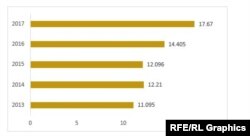While Iran has stopped releasing any official report on gas flaring levels since early 2015, new statistics published by Planning and Budget Organization indicate that the volume has increased significantly to 17.7 billion cubic meters (bcm) in 2017.
During oil production, the associated natural gas is flared when barriers to the development of gas markets and gas infrastructure prevent it from being exported.
Iran burns two-thirds of associated gas produced from oil fields due to lack of technologies and investments to collect them.
Last year, Oil Minister Bijan Namdar Zanganeh said that $5 billion is needed for curbing gas flaring.
However, such an investment seems impossible, at least in the short-term, due to U.S. sanctions and a heavy budget deficit. No foreign investor would even think of getting involve in Iran, especially in its oil sector.
The Planning and Budget Organization says that gas flaring volume was 15.7 bcm in 2016 and government had planned to decrease that to 11 bcm in a year. “Despite the plan, gas flaring level soared to 17.7 bcm in 2017”.
The value of this amount of gas is about $4.5 billion; if Iran could export it via pipelines to regional markets like its current clients Iraq and Turkey.
If Iran had developed its liquefied gas (LNG) plants, it could sell this volume of LNG at above $5.5 billion in East Asian or European markets.
According to the World Bank, Iran’s gas flaring volume increased by an average of 6.6% per year since 2013, when Hassan Rouhani assumed the presidency.
World Bank statistics show that Iran’s gas flaring level increased by 22.66% year-on-year in 2017, while the global averages decreased by 7.1% to 140 bcm.
Iran ranks third after Russia and Iraq in terms of gas flaring.
It also ranks seventh in terms of greenhouse emissions, with 672 million metric tons of CO2 annually, of which 35 million metric tons is due to gas flaring, according to Global Carbon Project.
Gas flaring is one of the serious problems affecting global climate change, as well as creating air pollution with consequences for the population’s health.
Last year, state daily Iran reported that 21,000 Iranian citizens die annually due to air pollution.
The report quoted former head of Department of Environment Masoumeh Ebtekar (replaced by Isa Kalantari last year) that air pollution costs $30 billion annually to the country, about three times more than in early 2010s.
World Bank’s latest statistics put the costs for Iran at $14 billion in 2013.
Carbon Dioxide (CO2), constitutes 80% of Iran’s total emissions. According to the International Energy Agency, Iran’s CO2 emissions volume has increased by 488% since Islamic Revolution (1979) to 563.4 million tons in 2016.








